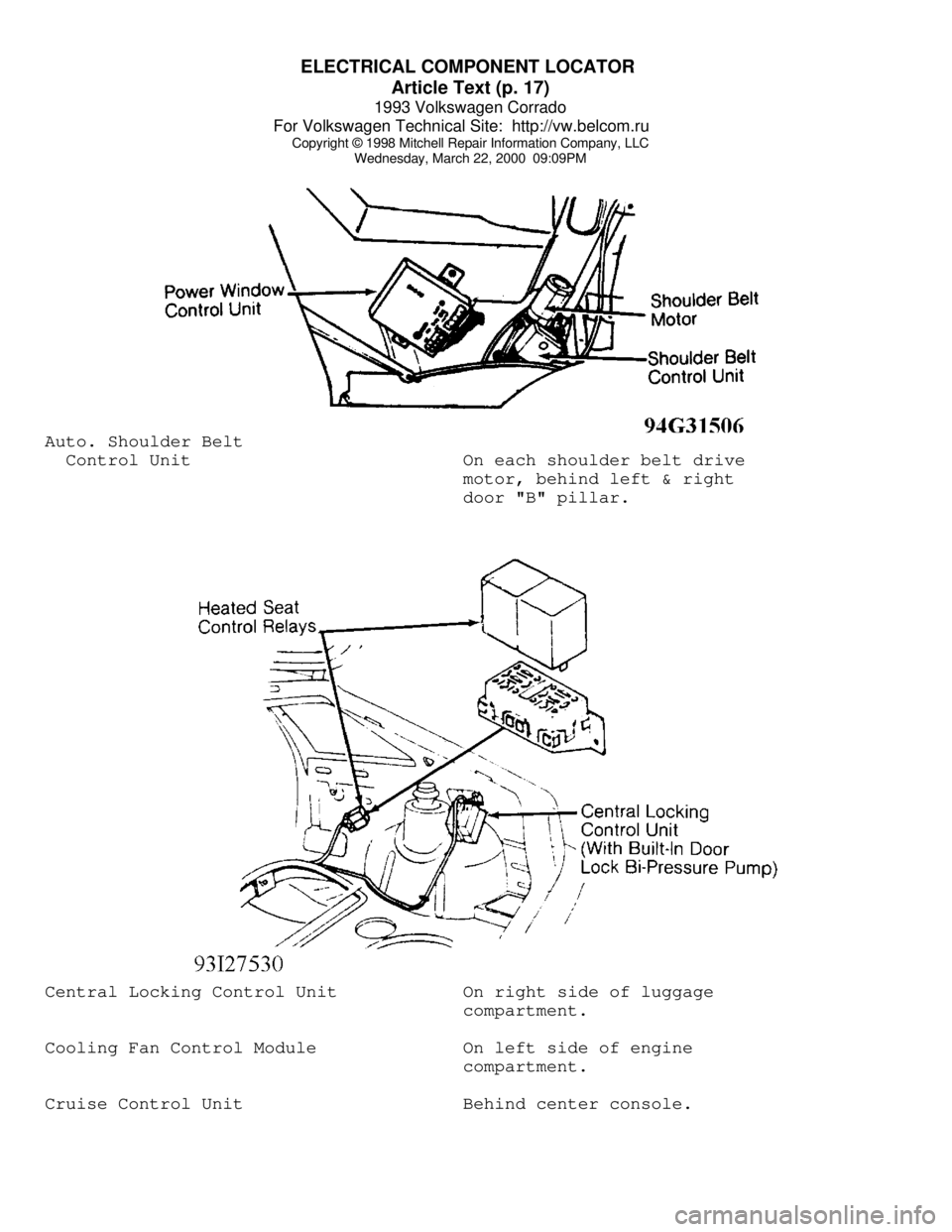1993 VOLKSWAGEN CORRADO center console
[x] Cancel search: center consolePage 385 of 920

A/C-HEATER SYSTEM - MANUAL
Article Text (p. 10)
1993 Volkswagen Corrado
For Volkswagen Technical Site: http://vw.belcom.ru
Copyright © 1998 Mitchell Repair Information Company, LLC
Wednesday, March 22, 2000 08:49PM
INSTRUMENT PANEL
Removal & Installation
1) Disable air bag system. See AIR BAG SYSTEM SAFETY article
in GENERAL SERVICING. Disconnect battery. Remove storage trays and
panel under left side of instrument panel. Remove steering wheel.
Remove trim panel around instrument cluster.
2) Remove center console. Remove dash vents at each side,
glove box and radio. Remove center storage box, A/C-heater control
panel trim, and A/C-heater control panel screws. Push A/C-heater
control panel away from instrument panel.
3) Remove screws at both sides of instrument panel, at center
support, and 2 screws next to windshield. Detach instrument panel and
pull part way out.
4) Disconnect wiring harnesses from instrument panel.
Disconnect speedometer cable, if present. Remove instrument panel. To
install, reverse removal procedure.
THERMOSTAT
Removal & Installation
1) Remove thermostat cover. See Fig. 3. Remove thermostat
mounting screw and disconnect harness connector. Remove thermostat by
pulling sensing (capillary) tube through grommet.
2) To install, reverse removal procedures. Measure back 13"
(330 mm) from end of sensing tube and tape spot. Insert sensing tube
into evaporator guide channel up to tape.
TORQUE SPECIFICATIONS
TORQUE SPECIFICATIONS TABLEÄÄÄÄÄÄÄÄÄÄÄÄÄÄÄÄÄÄÄÄÄÄÄÄÄÄÄÄÄÄÄÄÄÄÄÄÄÄÄÄÄÄÄÄÄÄÄÄÄÄÄÄÄÄApplication Ft. Lbs. (N.m)
A/C Compressor Bolt/Nut .................... 33 (45)
A/C Compressor Bracket Bolt/Nut ............ 25 (35)
A/C Compressor Hoses
Discharge ................................. 18 (25)
Suction ................................... 25 (35)
ÄÄÄÄÄÄÄÄÄÄÄÄÄÄÄÄÄÄÄÄÄÄÄÄÄÄÄÄÄÄÄÄÄÄÄÄÄÄÄÄÄÄÄÄÄÄÄÄÄÄÄÄÄÄ WIRING DIAGRAMS
Page 475 of 920

ELECTRICAL COMPONENT LOCATOR
Article Text (p. 17)
1993 Volkswagen Corrado
For Volkswagen Technical Site: http://vw.belcom.ru
Copyright © 1998 Mitchell Repair Information Company, LLC
Wednesday, March 22, 2000 09:09PMAuto. Shoulder Belt
Control Unit On each shoulder belt drive
motor, behind left & right
door "B" pillar.Central Locking Control Unit On right side of luggage
compartment.
Cooling Fan Control Module On left side of engine
compartment.
Cruise Control Unit Behind center console.
Page 492 of 920

ELECTRICAL COMPONENT LOCATOR
Article Text (p. 34)
1993 Volkswagen Corrado
For Volkswagen Technical Site: http://vw.belcom.ru
Copyright © 1998 Mitchell Repair Information Company, LLC
Wednesday, March 22, 2000 09:09PM
Back-Up Light Switch Mounted near gear selector
shaft on transmission.
Brake Fluid Level Switch In cap on brake fluid
reservoir.
Brake/Stoplight Switch On bracket, above brake pedal.
Cooling Fan Thermoswitch On lower left side of
radiator.
Clutch Switch On bracket, above clutch
pedal.Door Switch Mounted in door latch
assembly.
Oil Pressure Switches (2) On oil filter adapter housing.
MISCELLANEOUSÄÄÄÄÄÄÄÄÄÄÄÄÄÄÄÄÄÄÄÄÄÄÄÄÄÄÄÄÄÄÄÄÄÄÄÄÄÄÄÄÄÄÄÄÄÄÄÄÄÄÄÄÄÄÄÄÄÄÄÄÄÄÄÄÄÄÄÄÄÄComponent Component Location
ÄÄÄÄÄÄÄÄÄÄÄÄÄÄÄÄÄÄÄÄÄÄÄÄÄÄÄÄÄÄÄÄÄÄÄÄÄÄÄÄÄÄÄÄÄÄÄÄÄÄÄÄÄÄÄÄÄÄÄÄÄÄÄÄÄÄÄÄÄÄBlower Motor Resistor In bottom right of lower air
duct, near blower motor.
Data Link Connector (DLC) Under center console trim
Page 494 of 920

D - ADJUSTMENTS
Article Text
1993 Volkswagen Corrado
For Volkswagen Technical Site: http://vw.belcom.ru
Copyright © 1998 Mitchell Repair Information Company, LLC
Wednesday, March 22, 2000 08:59PM
ARTICLE BEGINNING
1993 ENGINE PERFORMANCE
On-Vehicle Adjustments
Corrado SLC
ENGINE MECHANICAL
Before performing any on-vehicle adjustments to fuel or
ignition systems, ensure engine mechanical condition is okay.
VALVE CLEARANCE
NOTE: All models use hydraulic lifters. No adjustments are
required.
IGNITION TIMING
NOTE: See ENTERING SELF-DIAGNOSTICS in the G - TESTS W/CODES
article in this section for additional scan tester
operating instructions.
VR6 IGNITION TIMING
1) Start and warm engine to normal operating temperature.
Ensure engine oil temperature is 176øF (80øC). Ensure A/C and
electrical loads are off, including cooling fan.
2) Connect engine analyzer to engine. Connect Scan Tester
(VAG 1551) to Data Link Connectors (DLC) located in center console, in
front of shift lever. Ensure no Diagnostic Trouble Codes (DTC) are
stored.
3) Ensure throttle position sensor is properly adjusted.
Ensure idle air control valve is okay. Valve must vibrate or hum.
Connect CO tester using Adapter (VAG 1363/3) on CO tap tube. DO NOT
remove oxygen sensor. Ensure exhaust system has no leaks.
4) Start engine and let it run at closed throttle (less than
1500 RPM). Operate scan tester and observe display. Press "1" button
to select RAPID DATA TRANSFER function. Press "Q" button to enter
input. Press right arrow button.
5) Press "0" and "1" buttons to select ENGINE ELECTRONICS
function. Press "Q" button to enter input. Press right arrow button,
then "0" and "4" buttons to select BASIC SETTING function. Press "Q"
button to enter input.
6) Press "0" and "1" buttons to select INPUT DISPLAY GROUP
NUMBER 01. Press "Q" button to enter input. Scan tester will display
SYSTEM IN BASIC ADJUSTMENT 1 through 4. Briefly increase engine speed
and then let it run for 2 minutes at closed throttle. Scan tester
displays idle speed in field one and ignition timing in field four.
Check CO level on CO tester.
7) When radiator cooling fan stops running, end basic setting
Page 495 of 920

D - ADJUSTMENTS
Article Text (p. 2)
1993 Volkswagen Corrado
For Volkswagen Technical Site: http://vw.belcom.ru
Copyright © 1998 Mitchell Repair Information Company, LLC
Wednesday, March 22, 2000 08:59PM
function by pressing right arrow button. Press "0" and "6" for END
OUTPUT function. Press "Q" button to enter input.
8) If idle speed, CO level or ignition timing is incorrect,
turn ignition off. Check accelerator pedal and throttle cable for ease
of operation. Check dashpot adjustment. Check throttle position
sensor, idle air control valve, and EGR valve.
IDLE SPEED & MIXTURE
NOTE: Mixture adjustment is NOT a part of normal tune-up procedure
and should not be performed unless mixture control unit is
replaced or vehicle fails emissions testing.
NOTE: Ensure fuel system pressure is correct before attempting
idle speed or mixture adjustment.
VR6 IDLE SPEED & MIXTURE ADJUSTMENT
See VR6 IGNITION TIMING under IGNITION TIMING near the
beginning of this article.
THROTTLE BODY
THROTTLE BODY ADJUSTMENT
CAUTION: Throttle limiting (stop) screw is set by manufacturer and
should NOT be moved. If screw is accidentally turned,
perform throttle body adjustment.
If stop screw for basic throttle adjustment has been moved,
replace throttle body.
DASHPOT
Open and close throttle until dashpot piston contacts roller.
With throttle in this position, check gap between limiter (stop) screw
and throttle. Gap between limiter (stop) screw and throttle lever must
be 0.10-0.14" (2.5-3.5 mm).
IDLE & FULL THROTTLE SWITCHES
THROTTLE POSITION (TP) SENSOR ADJUSTMENT
1) Connect Scan Tester (VAG 1551) to Data Link Connectors
(DLC) located in center console, in front of shift lever. Turn
ignition on. Operate scan tester and select RAPID DATA TRANSFER,
ENGINE ELECTRONICS, then READ MEASURING VALUE BLOCK functions.
2) Press "0" and "3" buttons to select INSERT DISPLAY GROUP
NUMBER 03 function. Press "Q" button to enter input. Slowly open
throttle, while observing display in channel 3, until throttle is wide
open. Numerical value must increase uniformly over entire opening
Page 583 of 920

G - TESTS W/CODES
Article Text
1993 Volkswagen Corrado
For Volkswagen Technical Site: http://vw.belcom.ru
Copyright © 1998 Mitchell Repair Information Company, LLC
Wednesday, March 22, 2000 09:11PM
ARTICLE BEGINNING
1993 ENGINE PERFORMANCE
Volkswagen Self-Diagnostics
Corrado SLC
INTRODUCTION
If no faults were found while performing preliminary
inspection procedures, proceed with self-diagnostics. If no fault
codes or only pass codes are present after entering self-diagnostics,
proceed to H - TESTS W/O CODES article for diagnosis by symptom (i.e.,
ROUGH IDLE, NO START, etc.).
NOTE: Scan Tester (VAG 1551) must be used to make full use of the
self-diagnostic system capabilities.
SELF-DIAGNOSTIC SYSTEM DESCRIPTION
Hard Failures
Hard failures of monitored sensors and/or components, cause
Malfunction Indicator Light (MIL) to come on and remain on until
problem is repaired. If malfunction indicator CHECK ENGINE light comes
on and remains on during vehicle operation, cause of malfunction must
be determined.
If malfunctions are present for more than 5 seconds, they are
stored as Diagnostic Trouble Codes (DTCs) and will be displayed as a
permanent malfunction even though the malfunction is not occurring at
the time DTCs are displayed. Malfunctions that affect oxygen sensor
control can only be read accurately after a test drive of at least 5
minutes.
Intermittent Failures
If a malfunction occurs for a maximum of 5 seconds, they are
stored and considered to be "sporadic" (intermittent failures). When
displayed on scan tester, malfunctions will have "SP" (sporadic) code.
RETRIEVING CODES
NOTE: See ENTERING SELF-DIAGNOSTICS for additional scan tester
operating instructions.
Corrado SLC
1) Turn ignition on. Connect Jumper Cable (357 971 514E) to
Data Link Connectors (DLC) located in center console. See Fig. 1.
Black end of jumper cable attaches to Black data link connector; White
end of cable attaches to White connector.
2) Leave jumper cable attached for 5 seconds, until on-board
diagnostic CHECK ENGINE light begins to blink. Remove jumper cable.
Allow on-board diagnostic code retrieval procedure to run until Code
Page 587 of 920

G - TESTS W/CODES
Article Text (p. 5)
1993 Volkswagen Corrado
For Volkswagen Technical Site: http://vw.belcom.ru
Copyright © 1998 Mitchell Repair Information Company, LLC
Wednesday, March 22, 2000 09:11PMÄÄÄÄÄÄÄÄÄÄÄÄÄÄÄÄÄÄÄÄÄÄÄÄÄÄÄÄÄÄÄÄÄÄÄÄÄÄÄÄÄÄÄÄÄÄÄÄÄÄÄÄÄÄÄÄÄÄÄÄÄÄÄÄÄÄÄÄÄÄ ENTERING SELF-DIAGNOSTICS
VAG ON-BOARD DIAGNOSTICS
NOTE: If VAG SELF-DIAGNOSIS (VAG ON-BOARD DIAGNOSTIC) display
does not appear on scan tester, check DLC terminals for
battery voltage and ground. Upper terminal should have
battery voltage, bottom terminals serve as ground.
Corrado SLC
1) Ensure battery voltage and fuses No. 18 and 22 are okay.
Ensure engine ground connections at cylinder head cover and at
manifold are okay.
2) Connect Scan Tester (VAG 1551) to Data Link Connectors
(DLC) located in center console, in front of shift lever. Attach Black
connector first, wait for VAG ON-BOARD DIAGNOSTIC display, then
connect White connector. DO NOT connect scan tester Blue connector.
3) Turn ignition on or start engine depending on function
being selected. See appropriate SELECTABLE FUNCTIONS table. Press "1"
button to select RAPID DATA TRANSFER function.
4) Press "0" and "1" buttons to select ENGINE ELECTRONICS
function. Press "Q" button to enter input. Electronic Control Module
(ECM) identification will be displayed on scan tester.
5) If CONTROL MODULE DOES NOT ANSWER message is displayed,
press HELP button to print a list of possible causes. With scan tester
in RAPID DATA TRANSFER function, press right arrow button. Press "02"
to "08" buttons to select desired function. Press "Q" button to enter
input.
SELECTABLE FUNCTIONS (CORRADO SLC) (1)
ÄÄÄÄÄÄÄÄÄÄÄÄÄÄÄÄÄÄÄÄÄÄÄÄÄÄÄÄÄÄÄÄÄÄÄÄÄÄÄÄÄÄÄÄÄÄÄÄÄÄÄÄÄÄÄFunction Ignition On Engine On
02 (Read DTC/Fault Memory) .. ..... ............. X
03 (Output Check/
03 Diagnostic Test Mode) ...... X .......... .....
04 (Start Basic Setting) ..... ..... ............. X
05 (Erase DTC/Fault Memory) .. ..... ............. X
06 (End Output) ............... X ............... X
08 (Read Measuring Value Block) X ............... X
(1) - Press HELP button at any time to obtain additional
scan tester operating instructions.
ÄÄÄÄÄÄÄÄÄÄÄÄÄÄÄÄÄÄÄÄÄÄÄÄÄÄÄÄÄÄÄÄÄÄÄÄÄÄÄÄÄÄÄÄÄÄÄÄÄÄÄÄÄÄÄ OUTPUT CHECK DIAGNOSIS (OUTPUT DIAGNOSTIC TEST MODE)
NOTE: See ENTERING SELF-DIAGNOSTICS for additional scan tester
operating instructions.
Page 588 of 920

G - TESTS W/CODES
Article Text (p. 6)
1993 Volkswagen Corrado
For Volkswagen Technical Site: http://vw.belcom.ru
Copyright © 1998 Mitchell Repair Information Company, LLC
Wednesday, March 22, 2000 09:11PM
Corrado SLC (2.8L)
1) Connect Scan Tester (VAG 1551) to Data Link Connectors
(DLC) located in center console, in front of shift lever. With scan
tester in OUTPUT DIAGNOSTIC TEST MODE, the injectors, Idle Air Control
(IAC) valve, evaporative frequency (solenoid) valve, oxygen sensor
relay, and EGR frequency valve (if equipped) may be actuated in
sequence listed.
2) The injector(s) must click by opening and closing
throttle. To trigger injectors 2 through 6, open and close throttle
once for each injector. If injector(s) do(es) not click, test
circuit(s) using the J - PIN VOLTAGE CHARTS article.
3) If injectors are okay, switch to next output test by
pressing the right arrow button. Press right arrow button to actuate
IAC valve. IAC valve must pulsate noticeably until switched to next
output test by pressing the right arrow button.
4) If IAC valve does not pulsate, turn ignition off.
Disconnect IAC valve and connect LED Tester (US 1115) to IAC valve
wiring harness connector using jumper wires from Adapter Kit (VW
1594).
5) Turn ignition on and repeat IAC valve output test. If LED
blinks, replace IAC valve. If LED does not blink, test circuit using
the J - PIN VOLTAGE CHARTS article in this section. If IAC and circuit
are okay, replace ECM.
6) If IAC valve pulsates properly, locate evaporative
frequency solenoid valve (located behind air cleaner housing, on
wheelwell). Disconnect hose, coming from fuel vapor canister, from
frequency solenoid. Attach auxiliary hose to solenoid.
7) Blow into auxiliary hose, in direction of throttle
housing, while performing solenoid output test (pressing right arrow
button to actuate evaporative frequency solenoid). If solenoid does
not actuate (open and close), disconnect wiring harness from solenoid.
Connect LED tester to solenoid wiring harness connector using jumper
wires from adapter kit.
8) Repeat evaporative solenoid valve output test. If LED
blinks, replace evaporative frequency solenoid valve. If LED does not
blink, test circuit using the J - PIN VOLTAGE CHARTS article. If
evaporative solenoid valve and circuit are okay, replace ECM.
9) If evaporative frequency solenoid operates properly, press
right arrow button to actuate oxygen sensor relay (mounted on
fuse/relay panel with a clip). If relay does not click, test relay and
its circuit using the J - PIN VOLTAGE CHARTS article.
10) If relay operates properly, press right arrow button to
actuate EGR frequency valve. Frequency valve must click until test
mode is switched to next output test by pressing the right arrow
button.
11) If frequency valve does not click, disconnect valve.
Connect LED tester using jumper wires from Adapter Kit (VAG 1594) to
frequency valve wiring harness connector.
12) If LED blinks, replace EGR frequency valve. If LED does
not blink, test circuit using the J - PIN VOLTAGE CHARTS article. If
EGR frequency valve and circuit are okay, replace ECM.
13) If EGR frequency valve operates properly, press right